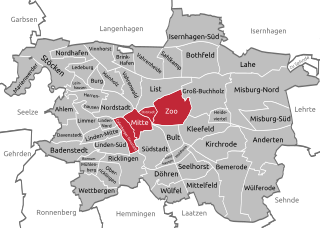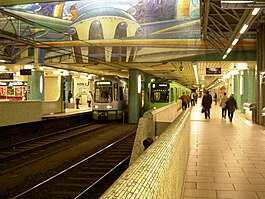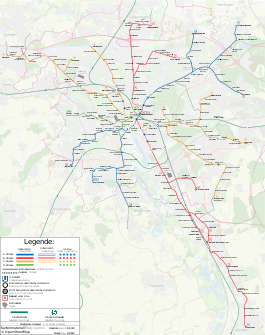
The Nuremberg U-Bahn is a rapid transit system run by Verkehrs-Aktiengesellschaft Nürnberg, which itself is a member of the Verkehrsverbund Großraum Nürnberg. The Nuremberg U-Bahn is Germany's newest metro system, having begun operation in 1972, although the Nuremberg-Fürth route (U1) uses part of the right of way of the Bavarian Ludwig Railway, Germany's first passenger railway opened in 1835. The current network of the U-Bahn is composed of three lines, serving 49 stations, and comprising 38.2 kilometres (23.7 mi) of operational route, making it the shortest of the four metro systems in Germany, behind Berlin, Hamburg and Munich.
The Hanover Fairground is an exhibition area in the Mittelfeld district of Hanover, Germany. Featuring 392,453 m² of covered indoor space, 58,000 m² of open-air space, 24 halls and pavilions, and a convention center with 35 function rooms, it is the largest exhibition ground in the world.

Hannover Hauptbahnhof is the main railway station for the city of Hanover in Lower Saxony, Germany. The railway junction is one of the 21 stations listed as a railway Category 1 station by DB Station&Service. It is also the most important public transport hub of the region of Hanover and it is served regional and S-Bahn services. The station has six platforms with twelve platform tracks, and two through tracks without platforms. Every day it is used by 250,000 passengers and 622 trains stop at the platforms. About 2,000 people work here.

Kröpcke is the central square of the city of Hanover in Germany. The square is situated at the crossroads of Georgstraße, Karmarschstraße, Bahnhofstraße and Rathenaustraße. It is named after Wilhelm Kröpcke, one of the owners of the former Café Robby, which was erected on the then-nameless square in 1869. Kröpcke leased the café in 1876, changed the business's name to Café Kröpcke and operated the café until 1919. Eventually, the square adopted the name from the café and in 1948 was officially named Kröpcke by the city of Hanover.

The Hanover S-Bahn is an S-Bahn network operated by DB Regio and Transdev Hannover in the area of Hanover in the German state capital of Lower Saxony. It went operational shortly before Expo 2000 and is focused on the Hanover region, and also connects with adjacent districts, and into the state of North Rhine-Westphalia. The S-Bahn is an evolution of a suburban railway.

The TW 400 is a type of tram vehicle formerly used on the tramways of Hanover, Germany, built from 1956 to 1958 by Duewag. Some units underwent remodeling to prepare them for being used on the Hanover Stadtbahn network but they were never used for this purpose.

Köln Hauptbahnhof or Cologne Central Station is a railway station in Cologne, Germany. The station is an important local, national and international transport hub, with many ICE, Thalys and Intercity trains calling there, as well as regional Regional-Express, RegionalBahn and local S-Bahn trains. EuroNight and Nightjet night services also call at the station. It has frequent connections to Frankfurt by way of the Cologne–Frankfurt high-speed rail line, which starts in southern Cologne. On an average day, about 280,000 travellers frequent the station, making it the fifth busiest station in Germany.

The Cologne Stadtbahn is a light rail system in the German city of Cologne, including several surrounding cities of the Cologne Bonn Region. The term Stadtbahn denotes a system that encompasses elements of trams as well as an underground railway network (U-Bahn) and interurban rail, even including three lines that are licensed as heavy rail and used by freight trains as well as Stadtbahn vehicles. Two of these lines connect the Cologne Stadtbahn to the Bonn Stadtbahn. These lines are jointly operated by both cities' transport authorities, resulting in both systems and the lines connecting them sometimes collectively referred to as Stadtbahn Rhein-Sieg.

The Stuttgart Stadtbahn is a light rail system in Stuttgart, Germany. The Stadtbahn began service on 28 September 1985. It is operated by the Stuttgarter Straßenbahnen AG (SSB), which also operates the bus systems in that city. The Stuttgart Stadtbahn is successor system of a tram network (Straßenbahnen) that characterized the urban traffic in Stuttgart for decades.

The Vienna S-Bahn is a suburban commuter rail network in Vienna, Austria. As opposed to the city-run urban metro network, the Vienna U-Bahn, it extends beyond the borders of the city, is operated by the ÖBB, and consists of many branch lines. S-Bahn is short for Schnellbahn, which can be translated as "rapid railway".

Düsseldorf Hauptbahnhof is the main railway station of Düsseldorf, the state capital of North Rhine-Westphalia, Germany.

Braunschweig Hauptbahnhof is a railway station in the German city of Braunschweig (Brunswick). It is about 1.5 km (0.93 mi) southeast of the city centre and was opened on 1 October 1960, replacing the old passenger station on the southern edge of the old town. The train services are operated by Deutsche Bahn, Erixx, Metronom and WestfalenBahn.

The Karlsruhe Stadtbahn is a German tram-train system combining tram lines in the city of Karlsruhe with railway lines in the surrounding countryside, serving the entire region of the middle upper Rhine valley and creating connections to neighbouring regions. The Stadtbahn combines an efficient urban railway in the city with an S-Bahn, overcoming the boundary between trams and trains. Its logo does not include the green and white S-Bahn symbol used in other German suburban rail systems and the symbol is only used at stops and stations outside the inner-city tram-operation area.

The Berlin North-South main line, also called the North-South link (Nord-Süd-Verbindung) is an electrified railway line in Berlin which was opened in 2006. It is an important component of the “mushroom concept” (Pilzkonzept) adopted for long-distance and regional rail services through the city. Its core is an approximately 3.5 km (2.2 mi) long Tiergarten tunnel under the Tiergarten in Berlin. The tunnel section includes the underground level of Berlin Hauptbahnhof and the Potsdamer Platz regional station. The above-ground section of the line includes the Berlin Südkreuz station.

Düsseldorf Wehrhahn station is located about one kilometre north of Düsseldorf Hauptbahnhof in central Düsseldorf in the German state of North Rhine-Westphalia. It is on the Cologne–Duisburg line and is classified by Deutsche Bahn as a category 4 station.

Mitte is the first borough of Hanover, the state capital of Lower Saxony. As of 2020, it has 36,645 inhabitants and consists of the quarters Mitte, Calenberger Neustadt, Oststadt and Zoo. The district mayor is Cornelia Kupsch (CDU).

S-Bahn Mitteldeutschland represents an enlargement of the previous Leipzig-Halle S-Bahn. It is an electric rail public transit system operating in the metropolitan area of Leipzig-Halle, Germany. This S-Bahn network developed from two separate S-Bahn networks of Halle (Saale) and Leipzig, which were established separately in 1969 and then linked in 2004. With the opening of the Leipzig City Tunnel on 15 December 2013 as a new artery, the network was extended for the first time to the federal states of Thuringia and Brandenburg. With a system length of 802 km (498 mi), it is the largest S-Bahn network in Germany, displacing the long-time title holder Rhine-Ruhr S-Bahn from that position. The locomotive-hauled double-decker trains partly dating back to the DDR-era have been largely replaced by electric multiple unit Bombardier Talent 2 trains, but some are still used during rush hour.

Steintor is a Hanover Stadtbahn station served by all C and D lines. The C lines were built underground, which is the junction for all lines continuing west. Lines 4, 5 and 16 branch off eastwards towards the next station, Königsworther Platz, while lines 6 and 11 branch off northbound, where the next station is Christuskirche.

The Essen Stadtbahn is a 19.6-kilometer (12.2 mi) light rail (Stadtbahn) network in Essen and the two neighbouring towns of Mülheim an der Ruhr and Gelsenkirchen in the German state of North Rhine Westphalia. It forms part of the Rhine-Ruhr Stadtbahn.

The Heilbronn Stadtbahn is a three line tram-train system in city of Heilbronn in the German state of Baden-Württemberg. It is based on the Karlsruhe model and operated jointly by the Albtal-Verkehrs-Gesellschaft (AVG), the Stadtwerke Heilbronn (SWH) and Deutsche Bahn (DB). It operates on normal railways under the Eisenbahn-Bau- und Betriebsordnung and within Heilbronn under the Verordnung über den Bau und Betrieb der Straßenbahnen.
























